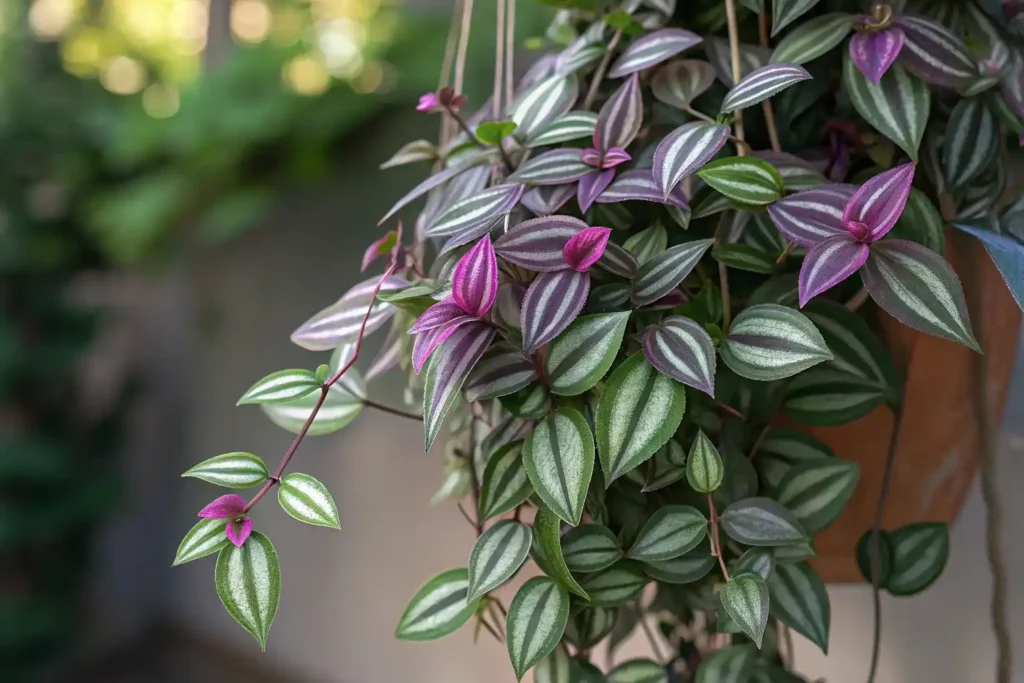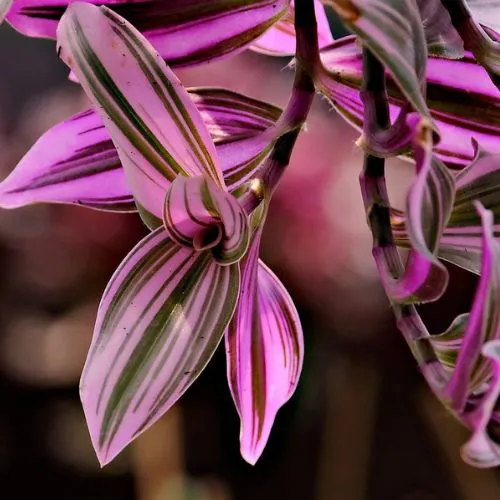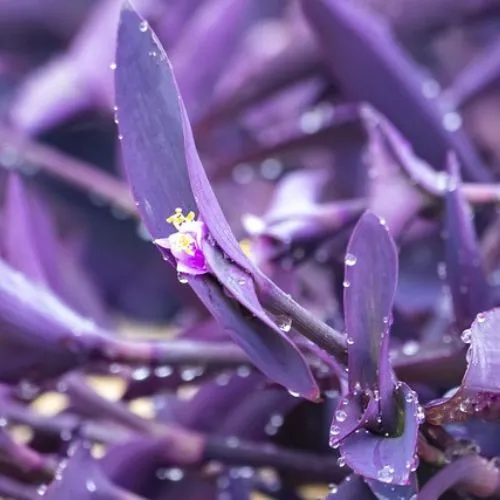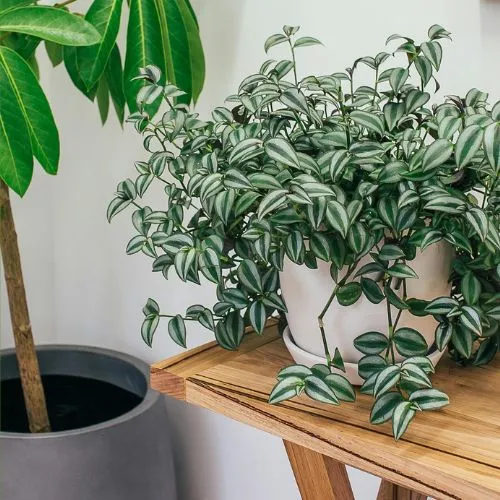In This Article
Do you dream of a lush, vibrant indoor garden that’s easy to maintain and full of charm? Meet Tradescentia, the beginner-friendly plant that turns ordinary spaces into extraordinary havens. With its striking colors and trailing vines, Tradescentia offers beauty and simplicity in one package. Whether you’re just starting your plant journey or adding to your collection, this guide will help you uncover everything you need to know to grow and love your plant. Let’s dive in!
| Common Name | Wandering Jew, Spiderwort, Inch Plant |
| Botanical Name | Tradescantia spp. |
| Family | Commelinaceae |
| Plant Type | Perennial, trailing, or spreading |
| Mature Size | 6-12 inches tall, spreads up to 24 inches |
| Bloom Time | Spring to summer |
| Toxicity | Mildly toxic to pets (can cause skin irritation) |
| Sun Exposure | Partial shade to full sun |
| Soil Type | Well-draining, moist soil |
| Soil pH | Slightly acidic to neutral (5.5-7.5) |
| Flower Color | Purple, blue, pink, or white |
| Hardiness Zones | 4-12 (varies by species) |
| Native Area | North & South America |

What is Tradescentia? A Beginner-Friendly Plant
It is a colorful, low-maintenance houseplant that’s perfect for beginners and experienced plant enthusiasts alike. Known for its trailing vines and vibrant foliage, this plant adds a unique charm to any indoor space.
Often called Wandering Jew or Spiderwort, it comes from Central and South America. It features striking leaves in shades of green, purple, or pink, depending on the variety. These eye-catching colors make it a favorite for hanging baskets or tabletops.
One of the reasons Tradescentia is beginner-friendly is its adaptability. It flourishes in bright, indirect light but is capable of adapting to lower light conditions. Additionally, it’s forgiving if you occasionally miss a watering.
Easy to grow and visually stunning, Tradescentia is a must-have for your plant collection.
Types of Tradescentia You’ll Love
Tradescentia is a versatile plant with several stunning varieties to choose from. Each type brings its own unique color and charm, making it easy to find one that fits your style. Here are three popular types you’ll love adding to your indoor garden.
1. Tradescentia Zebrina

This variety is one of the most popular for its striking leaves. Tradescentia Zebrina features a mix of green and purple stripes with a metallic sheen that catches the light beautifully. It’s perfect for hanging baskets or shelves where its trailing vines can be displayed.
2. Tradescentia Pallida

Often called the Purple Heart, this Tradescentia has bold, solid purple leaves that stand out in any room. Known for its hardiness, this plant flourishes under bright, indirect sunlight.
3. Tradescentia Fluminensis

This variety is known for its delicate, variegated leaves in green, white, and sometimes pink. It’s fast-growing and easy to propagate, making it a favorite for beginners. Tradescentia Fluminensis is ideal for filling empty spaces with lush greenery.
Why Choose a Tradescentia Variety?
Each type is low-maintenance, grows quickly, and adapts well to indoor environments.
With so many options to choose from, Tradescentia makes it easy to bring a pop of color and life into your home. Try one—or a mix of these varieties—for an indoor garden that’s as functional as it is beautiful.
How to Care for Tradescentia
Caring for your plant is simple, making it a favorite for plant lovers of all experience levels. Adhere to these guidelines to maintain your plant’s health and vibrancy.
Light Requirements
Tradescentia thrives in bright, indirect sunlight. Too much direct light can scorch its leaves, while low light may cause the colors to fade.
Watering Tips
Tradescentia prefers slightly moist soil but doesn’t tolerate overwatering. Water when the top inch of soil feels dry, ensuring your pot has drainage holes.
Soil and Fertilizer
Adding compost or a balanced liquid fertilizer once a month during the growing season helps Tradescentia thrive.
Humidity and Temperature
Tradescentia enjoys humidity, so consider misting it occasionally or placing it near other plants if the air is dry.
Pruning and Propagation
To maintain its shape and encourage growth, trim back any leggy vines. Propagate new plants by using cuttings, placing them either in water or directly into soil.
With proper care, your Tradescentia will reward you with vibrant foliage and a lush, trailing display. This plant is a fantastic addition to your home.
Common Problems and Solutions
Even though Tradescentia is a hardy plant, you may encounter a few issues. Don’t worry—most problems have simple fixes. Here’s how to tackle common challenges.
1. Yellowing Leaves
The appearance of yellow leaves is commonly a symptom of excessive watering or insufficient drainage. Check the soil—if it feels soggy, let it dry out before watering again. Make sure to use a pot with drainage holes and soil that drains well.
2. Leggy Growth
Leggy Tradescentia happens when the plant doesn’t get enough light. The stems grow long, and the leaves become sparse. Solve the problem by placing your plant in a brighter area with indirect sunlight. Trimming your plant often also helps it grow fuller.
3. Root Rot
Root rot is caused by waterlogged soil and can kill your plant if not addressed. If your plant is wilting but the soil is still moist, take a look at the roots. Healthy roots are white, while rotting ones are brown and mushy. Trim off damaged roots and repot the plant in fresh, dry soil.
4. Faded Colors
Tradescentia’s vibrant colors may fade in low light or with nutrient deficiencies. Ensure your plant gets enough light and feed it with a balanced liquid fertilizer during the growing season.
Creative Uses of Tradescentia in Your Home Decor
Tradescentia is not just easy to grow; it’s also a stunning plant that can elevate your home decor. Its vibrant foliage and trailing vines make it incredibly versatile for decorating your space. Here are a few creative ways to use Tradescentia in your home.
1. Hanging Baskets
The cascading vines of Tradescentia look beautiful in hanging baskets. Place them in a bright corner or near a window for a dramatic, eye-catching effect. The vibrant colors of Tradescentia can brighten up even the simplest spaces.
2. Shelf Styling
Tradescentia’s compact growth makes it ideal for shelves or mantels. Its trailing stems add a touch of greenery that softens hard edges and creates a cozy atmosphere. Pair it with books, candles, or other small plants for a curated look.
3. Table Centerpieces
Use Tradescentia as a living centerpiece for dining or coffee tables. Its colorful leaves add natural beauty and bring a sense of freshness to the room.
4. Vertical Gardens
Combine Tradescentia with other plants to create a vertical garden. Its vibrant hues contrast beautifully with ferns, ivy, or pothos for a dynamic display.
Tradescentia’s versatility makes it a perfect plant for enhancing your decor while purifying your indoor air. With its beauty and adaptability, you’ll find endless ways to style Tradescentia in your home.
Propagation Made Simple: Grow More for Free
Propagating Tradescentia is an easy and cost-effective way to expand your indoor garden. Whether you’re a beginner or an experienced plant parent, this process is straightforward and highly rewarding.
Step 1: Choose Healthy Cuttings
Select a healthy Tradescentia vine with at least two to three leaf nodes. Using clean scissors or pruning shears, make a cut just below a node. The node is where new roots will develop, so it’s important for propagation success.
Step 2: Prepare the Cutting
Remove the leaves closest to the cut end, leaving the top leaves intact. This prevents the cutting from rotting and ensures the energy goes toward root development.
Step 3: Root in Water or Soil
Submerge the nodes of the cutting in a glass of water. Keep it in a bright spot with indirect sunlight and refresh the water every few days. Within a week or two, you’ll notice roots forming.As another option, place the cutting directly into soil that is both moist and well-draining .
Step 4: Transplant and Care
Once the roots are about an inch long, transfer the cutting to a pot with soil. Water it lightly and place it in a well-lit area.
With minimal effort, you can propagate multiple Tradescentia plants to decorate your home or share with friends. It’s a simple, budget-friendly way to enjoy the beauty of Tradescentia while growing your indoor garden.
FAQs
Does Tradescentia need direct sunlight?
No, Tradescentia thrives in bright, indirect sunlight. Direct light may scorch its leaves, while low light can cause fading colors.
Can I grow Tradescentia outdoors?
Yes, you can grow it outdoors in warm climates. Please place it in a shaded spot to protect it from harsh sunlight.
Is Tradescentia safe for pets?
Tradescentia can be toxic to pets if ingested, so it’s best to keep it out of their reach.
How do I make Tradescentia fuller?
Prune leggy stems regularly to encourage bushier growth. Propagate cuttings to fill in gaps or create new plants.
Conclusion
Tradescentia is more than just a plant—it’s a gateway to creating a stunning, low-maintenance indoor garden. Its adaptability and beauty make it the perfect choice for any home. Now that you know how to care for and use creatively, why not take the first step in building your indoor oasis? Subscribe to our newsletter for more plant care tips, creative ideas, and exclusive updates to help your indoor garden thrive!

